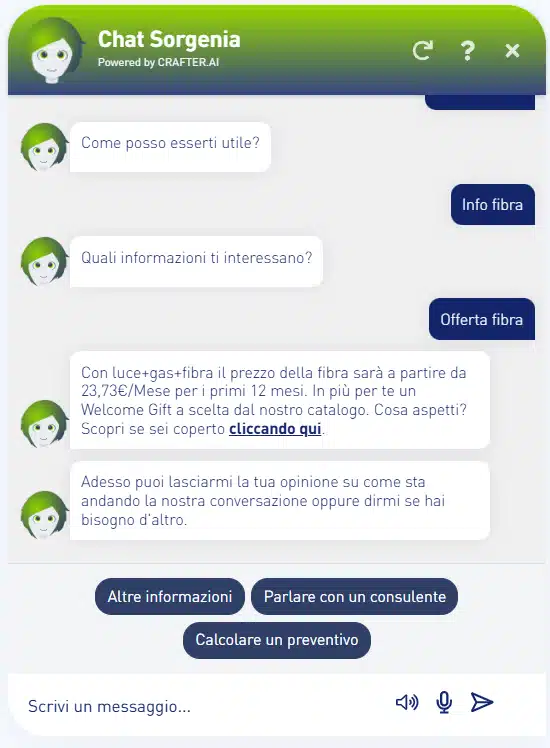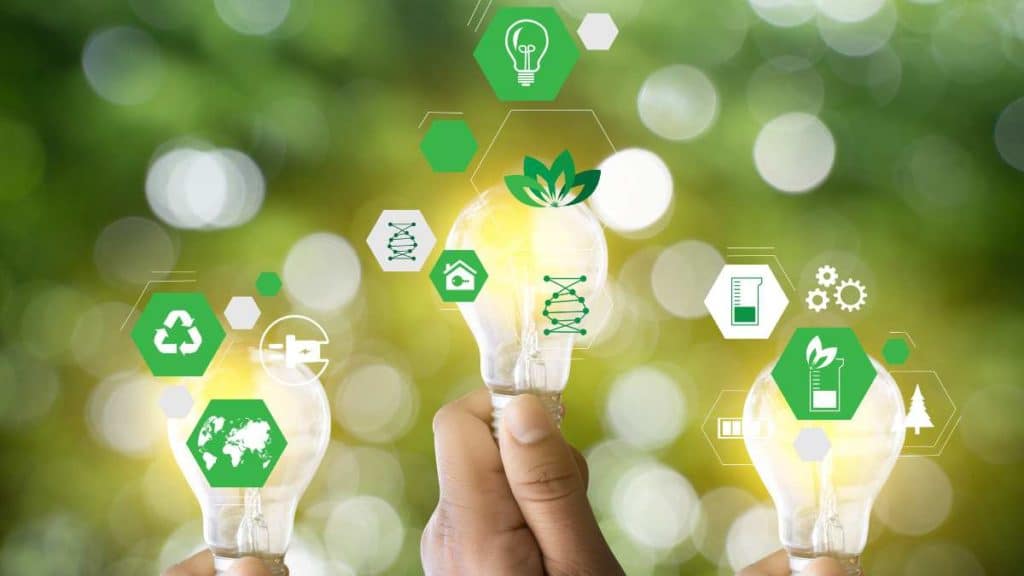The Energy & Utilities sector is a “service-oriented” business by definition and chatbots in the Energy market are able to bring the service provided to the highest levels.
The customer experience and the level of satisfaction of the customers of companies operating in this sector are in fact as important as the supplies of water or telecommunications.
In particular, in the energy market, those who contact customer service request quotes, make payments or check the balance of bills, report faults or request interventions. Simplifying these processes could make the difference between a satisfied customer and a disappointed customer, whose frustration often finds an outlet today on social media, with important repercussions on the company’s brand reputation.
Furthermore, the introduction of the free energy market has increased the level of competition between energy service providers and, in this scenario, customer satisfaction represents a determining and differentiating factor.
In particular, artificial intelligence solutions such as chatbots in the Energy market are able to support customer care management, processing large volumes of requests, simulating a one-to-one conversation, available 24/7.
Updated on July 7th 2025
Estimated reading time: 8 minutes
Table of contents
Chatbots in the Energy Market: Sorgenia’s Pre-sales Chatbot

Sorgenia is the first Italian Digital Energy Company that has used digital technology in its business strategy since 2016 and that approached chatbots in the Energy market since 2021.
Gea is Sorgenia’s virtual assistant, created to improve the digital experience of users and offer immediate and accessible support 24 hours a day, seven days a week. Thanks to this tool, Sorgenia has managed to approach a more digitalized customers, eager to learn about the offer without having to resort to the call center. Among chatnots in the Energy market, Gea is an advanced assistant that interacts dynamically with users, collects feedback, and presents itself as a real virtual consultant, able to interpret needs and propose customized solutions. The project, managed by a passionate multidisciplinary team, continues to grow and evolve, with particular attention to integrating the potential of generative artificial intelligence to offer increasingly complex consultancy. The goal is not to replace human operators, but to support them, simplifying and speeding up the work, while ensuring more effective and customized assistance.
For 5 years, the company’s customer care strategy has integrated the artificial intelligence of the customer care and pre-sales chatbot, which manages inbound customer requests, provides assistance in filling out subscription forms, performs up-selling actions, generates sales leads and works alongside call center operators, to whom it transfers requests that require human intervention, while remaining active in suggesting responses.
Interview with Alessandro Bertoli, ICT Director of Sorgenia (Released in 2021)

In a previous interview (April 2021), Alessandro Bertoli, Customer Service & ICT Director of Sorgenia, gave us a first-hand account of the challenges of the energy sector and how chatbots in the Energy market are representing a fundamental lever in building relationships with customers.
What are the big challenges for an Energy company today? How do you plan to face them?
“Our company’s challenges and goals are linked to the transition of production towards renewable and sustainable energies; in a complementary way, we aim to build a new ecosystem and a new relationship with customers that are protagonists of a distributed network of production, storage and services related to energy, that go beyond commodities and use digital technology as an fundamental asset for the overall functionality of this ecosystem. For Sorgenia, this is an acceleration and confirmation of our company’s strategy that is already underway”.
Our production’s system mixes our gas and steam combined cycle plants (that is indispensable and enabling in this transition phase), with the growing volume of energy produced from renewable sources that result from internal development projects and achievements and from targeted acquisitions: photovoltaic, wind, biomass, geothermal and water.
The relationship with our customers is increasingly digital, omnichannel and based on a strong environmental awareness and imprint. Also, on our web, social media and mobile applications are growing “Prosumers” communities and “Greeners” customers that have environmental sustainability at heart”.
In consideration of digital UX increasing importance, how Sorgenia guarantees the quality of user experience to customers?
“The quality of UX is essential to create a relationship based on Sorgenia’s simplicity, personalization, sustainability and sharing of the energy service. In order to be able to transmit and share these significant elements, we used the methodology of “design thinking” to design the UX path.
Today we continue with a Customer Experience team that uses Agile methodology to promote digital channels and work to guarantee consistency in view of services’ offer’s expansion, engagement’s increase on environmental sustainability issues, customer profiling and UX personalization.
The results of this process of UX continuous evolution are aligned to the challenging objectives we need to pursue and to the improvement of our customers’ satisfaction, that is also favoured by services’ costs reduction that also enables new business opportunities. “
What is the role of chatbots in the Energy market in your strategy?
“Chatbots are increasingly important channels for UX, providing support on existing channels, like web sales for example, and working as a separate channel to meet customers’ information and dispositive needs. The chatbot guarantees a 24/7 service and immediate response time to customer needs, contributing to customer’s satisfaction increase and decrease of number of interventions of call center operators.
An integrated design on processes and systems is essential to achieve these results as well as a chatbot that natively enables learning, that is equipped with artificial intelligence that allows dialogue customization at a high level of conversation and integrates basic conversation skills.
We are aware that the interface level will have to be furtherly improved, as well as the chat level will naturally evolve to voice interaction.
This also has an impact on the skills we need to manage the chatbot and, as well as in other areas, professionalism and collaboration roles are born between human and artificial intelligence: a sort of tutor that helps chatbots to evolve. “
Why did you choose CRAFTER.AI ?
We have considered several solutions and the one most in line with our goals and strategy turned out to be CRAFTER.AI
All in all, we have focused on its brain “quality” and “quantity” capabilities, in terms of number of intents and particularly on the easy processes and dialogues’ customization, as it is essential for us to interact directly with our chatbot tutors and business people, instead of IT developers.
Finally, we considered the possibilities and capabilities of integration and interaction with our CRM systems with which the CRAFTER.AI chatbot must interface.
We have started, by integrating the chatbot in the pre-sale area, that has allowed us to improve the success rate of new customers activation and now we are gradually extending it to the post-sale phase of Customer management.”
How to implement chatbots in the Energy market
To successfully implement a chatbot in the Energy market, it is essential to start from an in-depth analysis of customer needs and the business processes that you want to digitize or optimize.
- Analyze needs and processes
Identify customer needs and business processes that can be automated or simplified with the support of a chatbot, such as bill management, technical assistance or requesting quotes.
- Define objectives and KPIs
Establish what you want to achieve from the implementation (e.g. improving customer experience, reducing response times, increasing leads) and define Key Performance Indicators to measure its effectiveness.
- Choose the right platform
Opt for a flexible, scalable conversational AI platform that can be easily integrated with existing business systems (CRM, customer portal, billing systems).
- Design conversational flows and involve teams
Involve customer care, marketing and IT to build effective and natural conversations, define escalation processes towards human operators and ensure consistency with the brand voice.
- Monitor, Improve, and Communicate
Once activated, monitor the performance of the chatbot, analyze the data collected to continuously improve the dialogues and promote the service to customers to encourage its adoption.
Conclusions
Sorgenia’s experience shows how chatbots in the Energy market are not just automation tools, but real strategic allies in building a solid, personalized and continuous relationship with the customer. In a constantly evolving sector, where sustainability, digitalization and quality of service represent the new competitive standards, solutions like those of Crafter.ai are essential to guarantee operational efficiency, customer satisfaction and constant innovation. Investing in conversational artificial intelligence means not only optimizing processes, but also offering a simpler, more accessible user experience that is consistent with the values of a modern and responsible company.
Faqs – Chatbots in the Energy market
Chatbots allow you to offer a customer service available 24/7, reducing waiting times and improving the customer experience. They automate repetitive tasks such as managing bills, sending estimates or reporting faults, lightening the load on operators and allowing them to focus on more complex requests. Furthermore, they help improve brand reputation and reduce operating costs.
The latest generation chatbots, thanks to artificial intelligence and natural language processing, are able to manage complex conversations, offer personalized advice and interpret user requests. They can also recognize when the involvement of a human operator is necessary and transfer the conversation without interruptions, ensuring continuity and quality in the service.
Among the most common activities automated by chatbots in the Energy sector are: requesting and sending quotes, managing bills and payments, reporting faults or anomalies, booking technical interventions, assistance with contracts and promoting commercial offers. Chatbots can also support sustainability campaigns and green customer engagement, becoming an integral part of the digital communication strategy.
Updated on: July 7th 2025

